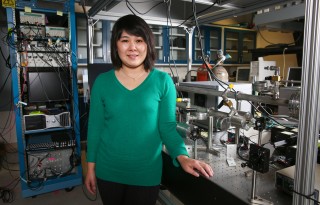Feb 17 2016
Scientists at The University of Alabama in Huntsville (UAH) have used UAH’s Rocket-city Ozone (O3) Quality Evaluation in the Troposphere (RO3QET) Lidar to measure ozone that was chemically produced by summertime lightning over the United States, research that could be important to air quality prediction and assessment once it is developed further.
 UAH Earth Systems Science Center research associate Dr. Dr. Lihua “Lucy” Wang in UAH’s Rocket-city Ozone (O3) Quality Evaluation in the Troposphere (RO3QET) Lidar Laboratory. Credit: Michael Mercier / UAH
UAH Earth Systems Science Center research associate Dr. Dr. Lihua “Lucy” Wang in UAH’s Rocket-city Ozone (O3) Quality Evaluation in the Troposphere (RO3QET) Lidar Laboratory. Credit: Michael Mercier / UAH
“This is the first time in the United States that we have used high-resolution Lidar data to determine lightning’s impact on tropospheric ozone,” says Dr. Lihua “Lucy” Wang, a UAH Earth Systems Science Center (ESSC) research associate who was the lead author of a research paper on the team’s findings.
The ESSC team used data from a Lidar facility on the top floor of The National Space Science Technology Center (NSSTC) in Cramer Research Hall, one of just five such atmospheric Lidar facilities in the U.S. and about 15 worldwide.
Lidar uses a laser beam to collect data, so it is effective only during clear conditions. Vaisala’s U.S. National Lightning Detection Network (NLDN) monitors total lightning activity across the continental United States, 24 hours a day, 365 days a year. The UAH team estimated lightning nitric oxide (NO) emissions based on NLDN observations, measured the resulting ozone created by the lightning downwind of the storms, where clear conditions allowed Lidar to function and quantified the ozone enhancements due to lightning.
The troposphere is the lowest layer of atmosphere on Earth and produces the planet’s weather. Above it is the stratosphere, a layer of thinner atmosphere. The denser troposphere is separated from the stratosphere by a large temperature inversion called the tropopause.
Tropospheric ozone – a greenhouse gas and the kind that affects the air we breathe – can increase in concentration because of atmospheric conditions, or can result from human activities. In the winter, intermixing of stratospheric ozone with the troposphere in a process called Stratospheric Tropospheric Exchange (STE) is the chief means of ozone transport into our air, but Dr. Wang says in summertime that process subsides and lightning bolts create significant ozone enhancements in the middle to upper troposphere, particularly in the Southeastern US.
“During the summertime, the lightning produced very important ozone enhancements in the upper troposphere. When lightning introduces ozone into the upper troposphere, there is some downward transport mechanism that will affect lower tropospheric ozone ” Dr. Wang says.
“In the troposphere, ozone is considered a bad gas,” says Dr. Wang. “It can worsen bronchitis, emphysema and asthma.” If ground-level ozone exceeds 70 parts per billion, the U.S. Environmental Protection Agency issues an air quality advisory.
“We are investigating the processes that influence the ozone production,” Dr. Wang says. The first Lidar measurements of lightning-generated ozone have opened a door to further research. “There are still many uncertainties in this research that we are trying to improve upon.”
Co-authors of the research paper are Melanie B. Follette-Cook of Morgan State University in Baltimore; Mike Newchurch of UAH; Kenneth E. Pickering of NASA Goddard Spaceflight Center in Greenbelt, Md.; Arastoo Pour-Biazar of UAH; Shi Kuang of UAH; William Koshack of NASA Marshall Space Flight Center in Huntsville; and Harold Peterson of the Universities Space Research Association in Huntsville.
About The University of Alabama in Huntsville
The University of Alabama in Huntsville is a Tier 1 research university that prepares students for demanding positions in Engineering, the Sciences, Business, Nursing, Education, and the Arts, Humanities, and Social Sciences. Located within one of the largest research parks in the United States, UAH is considered one of the nation's premier research universities.